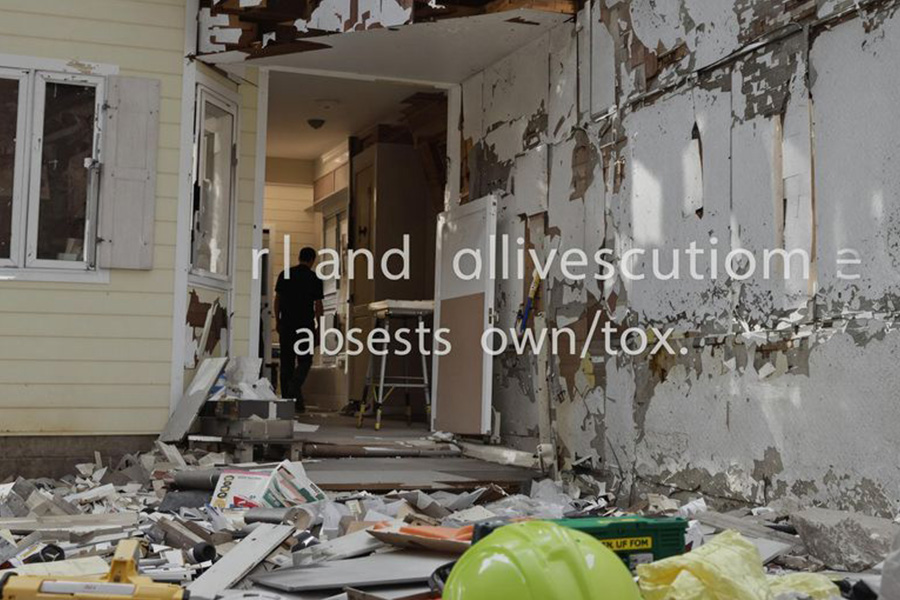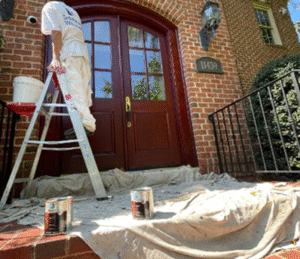Asbestos in Residential Properties

What Is Asbestos and Why Was It Used?
Asbestos refers to a group of naturally occurring minerals known for their heat resistance and durability. For decades, it was used in construction materials like insulation, roofing, and cement because of its affordability and strength. While it served its purpose, the discovery of its health risks eventually led to its decline in use. However, many older homes still contain asbestos in various forms, creating potential challenges for homeowners and buyers alike.
Health Risks Associated with Asbestos
Exposure to asbestos fibers can lead to significant health issues, including lung diseases like asbestosis, mesothelioma, and lung cancer. These risks are particularly concerning in spaces like a home or rehab facility, where people spend extended periods. The danger arises when asbestos-containing materials are damaged or disturbed, releasing fibers into the air. Long-term inhalation of these fibers is the primary cause of these illnesses. Understanding these risks is vital, especially for families or individuals considering buying a property with asbestos.
Common Locations of Asbestos in Homes
Asbestos can be found in several areas of a house, particularly in properties built before the late 1990s. Common locations include:
- Insulation around boilers and pipes.
- Cement roofing and siding materials.
- Floor tiles and adhesives.
- Decorative wall coatings like Artex.
- Loose-fill insulation in attics.
For anyone considering buying or renovating a home, or even converting it into a specialized space like an addiction rehab center, identifying these materials is essential. A professional asbestos survey can help pinpoint its presence and guide safe management or removal strategies.
Challenges of Getting a Mortgage on a House with Asbestos
Why Lenders Are Cautious About Asbestos
Lenders often hesitate when it comes to properties with asbestos due to the potential health and financial risks involved. Asbestos, if disturbed, can release harmful fibers into the air, posing serious health concerns. This makes the property less appealing as collateral. Additionally, the cost of treatment or removal can be significant, which adds to the lender’s concerns. They worry about the property’s marketability and resale value if they need to repossess it.
Impact of Asbestos on Property Valuation
The presence of asbestos can lower a home’s value, sometimes significantly. Appraisers take into account the cost of remediation and the potential risks associated with the material. For example, if asbestos is found in critical areas like insulation or roofing, the valuation may drop to reflect the anticipated expenses for safe treatment. This reduced valuation can also affect the loan-to-value ratio, making it harder for borrowers to meet lender criteria.
Legal and Disclosure Requirements
When buying or selling a property with asbestos, legal disclosure is non-negotiable. Sellers are typically required to inform potential buyers about any known asbestos-containing materials (ACMs) in the home. Failure to do so can result in legal consequences. For buyers, understanding these disclosures is essential, as it affects not only the mortgage process but also future responsibilities for treatment or management of the asbestos. Lenders often require proof of compliance with these disclosure laws before approving a mortgage.
Steps to Secure a Mortgage for a Property with Asbestos
Conducting an Asbestos Survey
Before applying for a mortgage, it’s essential to arrange a professional asbestos survey. This survey identifies areas of concern, assesses the condition of asbestos materials, and provides recommendations for management or removal. Lenders often require this documentation to evaluate the property’s risk.
Key steps include:
- Hiring a licensed asbestos inspector to conduct a thorough analysis.
- Reviewing the survey results to understand the scope of remediation needed.
- Using the findings to negotiate with the seller, potentially lowering the purchase price or asking for remediation before closing.
Working with Specialized Mortgage Brokers
Not all lenders are open to financing properties with asbestos. This is where specialized mortgage brokers come in. These brokers have experience with unique cases and can connect buyers with lenders who understand the risks and requirements of asbestos-containing properties.
Benefits of working with a specialized broker:
- Access to lenders with flexible terms for asbestos-related risks.
- Guidance on preparing your application to meet lender expectations.
- Support in navigating specific requirements, such as remediation plans or additional inspections.
Meeting Lender-Specific Criteria
Each lender has its own policies when it comes to asbestos. Some may require proof of safe management, while others might insist on complete removal before approving the mortgage.
To improve your chances:
- Provide the asbestos survey results as part of your application.
- Show evidence of planned or completed remediation work, if required.
- Be prepared to discuss additional costs, such as asbestos removal or containment, as part of your budget.
In some cases, buyers may need to explore alternative lending options if traditional lenders decline their application. By taking these steps, securing a mortgage for a property with asbestos becomes a more manageable process, even with the challenges involved.
Remediation and Management of Asbestos
Options for Asbestos Remediation
When asbestos is found in a home, homeowners have two main paths to address the issue: remediation or removal. Remediation focuses on containing the asbestos to prevent exposure, while removal involves safely extracting and disposing of the material. Choosing between these options depends on factors like the condition of the asbestos and planned renovations. For instance:
- If the asbestos is intact and undisturbed, encapsulation (sealing it in place) might be sufficient.
- For damaged or friable asbestos, professional removal is often the safer choice.
- Always consult a licensed asbestos specialist to determine the best course of action.
Costs Involved in Asbestos Removal
The cost of asbestos removal can vary widely, depending on the size of the property and the extent of contamination. Homeowners should budget for:
- Initial asbestos surveys and testing.
- Professional removal services, which often charge based on square footage.
- Post-removal air quality testing to ensure safety.
While these costs can add up, addressing asbestos issues early can make the property more marketable and avoid potential legal troubles down the road. Some rehab loans may even cover asbestos removal expenses, helping to offset the financial burden.
Importance of Professional Asbestos Management
Handling asbestos is not a DIY task. Disturbing asbestos without proper precautions can release harmful fibers into the air, posing severe health risks. Professional asbestos contractors are trained to:
- Assess the risk and recommend appropriate actions.
- Use specialized equipment to safely manage or remove asbestos.
- Comply with local regulations and disposal guidelines.
Hiring experts ensures the safety of everyone involved and protects the property’s value. Whether opting for remediation or removal, professional management is key to addressing asbestos concerns effectively.
Lender Perspectives on Asbestos-Containing Properties
How Lenders Assess Risk
Lenders approach properties with asbestos cautiously due to the potential health and financial risks involved. The presence of asbestos raises concerns about safety and long-term property value, making it a key factor in mortgage decisions. Lenders may require a detailed asbestos survey to determine the extent and condition of the asbestos. If the material is intact and unlikely to be disturbed, some lenders might be more flexible. However, if the asbestos is damaged or located in high-risk areas, they may hesitate to approve the loan.
Criteria for Mortgage Approval
Each lender sets specific criteria when evaluating properties with asbestos. Here are some common considerations:
- Location and condition: If the asbestos is in good condition and not likely to pose an immediate risk, lenders may proceed cautiously. Damaged asbestos, on the other hand, often triggers stricter requirements.
- Remediation plans: Some lenders may require a clear plan for asbestos removal or containment before approving a mortgage.
- Property valuation: The costs associated with asbestos remediation can lower the property’s value, impacting the loan amount a lender is willing to offer.
Specialized lenders may have more relaxed criteria, but they often require additional documentation, such as inspection reports or remediation estimates.
Alternatives if Declined by a Lender
If a traditional lender declines a mortgage application due to asbestos, buyers still have options:
- Seek out specialized lenders who are experienced in dealing with asbestos-containing properties.
- Work with a mortgage broker to find lenders with flexible policies.
- Consider addressing asbestos issues upfront, such as arranging for professional remediation, to make the property more appealing to lenders.
While securing a mortgage for a property with asbestos can be challenging, understanding lender perspectives and preparing accordingly can make the process smoother.
Legal and Insurance Considerations for Asbestos Properties
Disclosure Obligations for Sellers
When selling a property that contains asbestos, disclosure is not optional—it’s a legal requirement in most regions. Sellers must inform potential buyers about the presence of asbestos-containing materials (ACMs) in the home. Failing to disclose this information can result in serious legal consequences, including lawsuits or financial penalties. Buyers, on the other hand, are encouraged to request a thorough asbestos survey if one hasn’t already been performed. This ensures transparency and helps avoid disputes later on.
Insurance Coverage for Asbestos Risks
Homeowners insurance policies often have specific exclusions or limitations when it comes to asbestos-related issues. Standard policies may not cover the costs of asbestos testing, removal, or any health claims stemming from exposure. It’s a good idea for homeowners to review their policies closely and consider obtaining additional coverage if asbestos is present. Specialized endorsements, which provide added protection for asbestos-related risks, might be worth exploring. Understanding these limitations can save homeowners from unexpected expenses down the line.
Legal Implications of Undisclosed Asbestos
Undisclosed asbestos can lead to a web of legal problems. If a buyer discovers asbestos after the sale and it wasn’t disclosed, they may have grounds to sue the seller for misrepresentation or negligence. This could result in costly legal battles and even the reversal of the sale. For landlords, the stakes are equally high. Legal responsibilities often require them to test for asbestos and ensure tenant safety. Ignoring these duties might lead to fines or lawsuits. For more details on these legal responsibilities, refer to asbestos-related laws and regulations enforced by federal agencies.
The Role of Surveys and Inspections
Importance of a Detailed Property Survey
A thorough property survey is often the first step in addressing asbestos issues in residential properties. These surveys go beyond basic home inspections by specifically identifying areas where asbestos is present. Lenders often require detailed asbestos surveys before approving a mortgage to ensure the property is safe for occupancy and meets financial risk criteria. Without this documentation, securing financing can become a significant hurdle.
What Inspectors Look for in Asbestos Cases
Asbestos inspectors focus on several key aspects during their evaluations:
- Identifying the materials containing asbestos and their locations.
- Assessing the condition of the asbestos and whether it poses an immediate risk.
- Determining if the asbestos is likely to become airborne or disturbed during renovations or daily use.
These findings help inform both buyers and lenders about the potential risks and costs associated with the property.
How Survey Results Affect Mortgage Approval
The results of an asbestos survey can have a direct impact on mortgage approval. If the survey reveals significant risks, some lenders may decline the application outright. Others might impose conditions, such as requiring the asbestos to be professionally managed or removed before finalizing the loan. Buyers can also use the survey results to negotiate the property price or request remediation before purchase. Partnering with experienced professionals, like those at Evoke Wellness, ensures accurate assessments and guidance throughout this process.
Special Considerations for Asbestos Roofs
Why Asbestos Roofs Are Treated Differently
Asbestos roofs are often viewed differently by lenders compared to other parts of a property containing asbestos. The reason is simple: the roof is less likely to be disturbed during daily use, meaning the risk of releasing harmful fibers is lower. However, asbestos roofing materials can deteriorate over time, especially when exposed to natural elements like UV rays, frost, and acid rain. This degradation increases the likelihood of fibers becoming airborne, which poses significant health risks.
Lenders typically evaluate the condition of the roof. If the structure is intact and undamaged, many lenders may approve a mortgage. But if the roof shows signs of wear or damage, the property might be flagged for repairs or even asbestos removal before financing can proceed.
Survey Recommendations for Asbestos Roofs
A detailed property survey is crucial when dealing with asbestos roofs. Inspectors will assess the condition of the roofing material and identify whether it poses an immediate threat or requires attention. Here are some key points inspectors focus on:
- The overall condition of the roof and signs of deterioration.
- Potential for asbestos fibers to become airborne.
- Presence of asbestos in other parts of the property.
It’s strongly advised to hire professionals for this survey. Not only does this reassure lenders, but it also ensures the safety of future occupants.
Lender Policies on Asbestos Roofs
Mortgage lenders have varying policies when it comes to asbestos-containing roofs. Some are more lenient if the roof is in good shape, while others may require proof that the asbestos poses no health risks. Here’s what borrowers need to know:
- Condition Matters: Lenders are more likely to approve a mortgage if the roof is undamaged and well-maintained.
- Survey Reports Are Key: A comprehensive survey can help demonstrate that the asbestos is contained and doesn’t impact the property’s safety.
- Contingency Plans: In cases where the lender is hesitant, buyers might need to negotiate repairs or removal costs with the seller.
For properties with asbestos roofs, working with a specialized mortgage broker can make the process smoother. They can help identify lenders who are more familiar with asbestos-related risks and policies.
If you’re considering buying a home with an asbestos roof, it’s essential to understand these unique challenges and take the necessary steps to address them.
Tips for Buyers Considering Properties with Asbestos
Questions to Ask Before Buying
When considering a property with asbestos, potential buyers should start by asking the right questions. Is the asbestos intact or disturbed? This is critical because undisturbed asbestos often poses less risk. Buyers should also inquire about whether an asbestos survey has already been conducted and, if so, request a copy of the report. Knowing the location and condition of asbestos-containing materials in the home is essential. Additionally, ask the seller if any remediation work has been done or if quotes for removal have been obtained.
Negotiating Repairs or Remediation
Negotiation can be a powerful tool when dealing with properties that have asbestos. Buyers might ask the seller to reduce the price to account for potential remediation costs. Alternatively, they could request that the seller handle the removal or containment of asbestos before closing the deal. If the seller is unwilling to negotiate, buyers should weigh the long-term costs of managing or removing asbestos against the property’s value. Remember, the presence of asbestos can also affect future resale potential, so factor that into your decision-making process.
Finding the Right Mortgage Lender
Securing a mortgage for a property with asbestos can be tricky, as not all lenders are willing to finance such homes. Buyers should look for lenders experienced with asbestos-related risks. Specialized mortgage brokers can also help identify lenders who are more flexible in these situations. Keep in mind that lenders may require additional inspections or certifications to ensure the property is safe. Working with a knowledgeable broker can simplify the process and increase the chances of approval.
For more insights on how asbestos affects home value, read this guide.
Future Trends in Asbestos and Mortgages
Evolving Lender Policies
Mortgage lenders are gradually adapting their policies regarding properties with asbestos. Many lenders are now considering the specific condition and location of asbestos, rather than outright rejecting applications. This shift acknowledges that undisturbed asbestos poses minimal risk. As awareness grows, specialized mortgage products for such properties may become more common, offering buyers greater flexibility.
Advancements in Asbestos Management
The field of asbestos management is seeing significant progress. Innovative technologies are emerging to detect and assess asbestos more accurately and efficiently. Non-invasive testing methods, for instance, are reducing the need for costly and intrusive surveys. These advancements could lower the financial barriers for buyers and lenders alike, making asbestos properties less daunting.
Impact of Regulatory Changes
Regulations surrounding asbestos are continuously evolving. Governments and environmental agencies are introducing stricter guidelines for handling, disclosure, and remediation. While these changes aim to enhance safety, they also influence the mortgage process. Buyers and sellers may face additional requirements, such as mandatory surveys or remediation plans, which could impact timelines and costs. Staying informed about these updates is essential for anyone navigating the intersection of asbestos and real estate.
For more on asbestos-related considerations, consult this Legal Backgrounder detailing potential claims and litigation trends.






